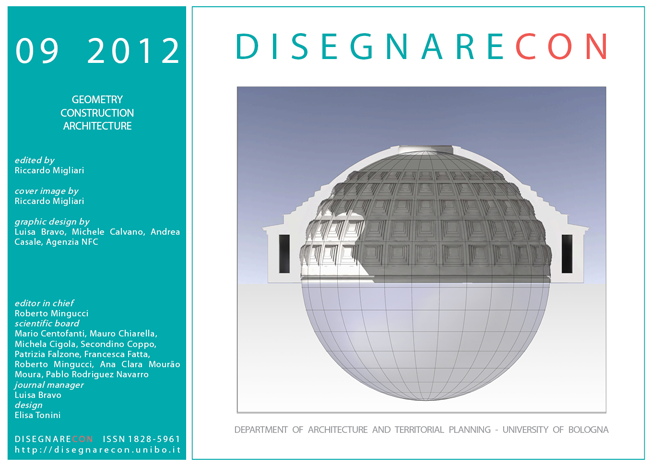The role of descriptive geometry in graphic design
DOI:
https://doi.org/10.6092/issn.1828-5961/3173Keywords:
graphic communication, graphic design. image, projective geometry, descriptive geometry, homological transformationsAbstract
Frequently it has been discussed the role of descriptive geometry in the process of analysis and configuration of architecture, recognizing it an unquestioned even in the information age. Less investigated is rather the role of this discipline in the graphic design, a field in which the image is the essence of communication.
Then, in the image definition, especially when this must become part of a multi-directional communication the contribution of the geometry seems crucial.
This paper, on the basis of the teaching and research experience specifically oriented to graphic design, intends to highlight the deep connections between the structuring of the graphic image (lettering, corporate image, brand image, product image etc.) and the projective and descriptive geometry.
References
Bohem, Gottfried (2006), La questione delle immagini, in Di Monte, Maria Giuseppina, a cura di, Immagine e scrittura, Meltemi, Roma [Die Bilderfrage, in Boehm, Gottfried (1994) Was ist ein Bild?, hg., Fink, München, pp. 325-343], pp. 43-58.
Bohem, Gottfried (2009), Fra l’occhio e la mano. Le immagini come strumenti di conoscenza, in Di Monte, Maria Giuseppina, Di Monte, Michele, a cura di, La svolta iconica, Meltemi, Roma [Zwischen Auge und Hand: Bilder als Instrumente der Erkenntnis, in Heinz, Bettina, Huber, Jörg (2001), hg., Mit dem Auge denken. Strategien der Sichtbarmachung in wissenschaft- lichen und virtuellen Welten, Institut für der Gestaltung und Kunst Zürich (ith),
Zürich, pp. 43-54], pp.213-227.
Bohem, Gottfried (2009), Il ritorno delle immagini, in Di Monte, Maria Giuseppina, Di Monte, Michele, a cura di, La svolta iconica, Meltemi, Roma [Die Wiederkehr der Bilder, in Boehm, Gottfried (1994) Was ist ein Bild?, hg.,
Fink, München, pp. 11-38], pp. 37-67.
Danto, Arthur C. (2008), La trasfigurazione del banale, Laterza, Roma-Bari.
Dorfles, Gillo (2001), Introduzione al disegno industriale, Einaudi, Torino.
Durand, Gilbert (2009), Le strutture antropologiche dell’immaginario, Dedalo, Bari, [(1963), Les structures anthropologiques de l’immaginaire, Presses Universitaires de France, Paris].
Eco, Umberto (1998), Trattato di semiotica generale, Bompiani, Milano.
Fischbein, Efraim (1993), The theory of figural concepts, in Educational Studies in Mathematics, Springer, 24 (2), 1993, pp. 139-162.
Gensini, Stefano (2004), Manuale di semiotica, Carocci, Roma.
Goodman, Nelson (2003), I linguaggi dell’arte, Il Saggiatore, Milano [(1968) Languages of Art: An Approach to a Theory of Symbols, Bobbs-Merrill, Indianapolis].
Hegel, Georg Whilelm Friedrich (1972), Estetica, Einaudi, Torino.
Katz, David (1979), La psicologia della forma, Boringhieri, Torino [(1948) Gestaltpsycologie, Benno Schwabe & co, Basilea].
Kepes, György (1971), Il linguaggio della visione, Dedalo, Bari,[(1944), Language of Vision, Paul Theobald & co., Chicago].
Morris, Charles (1955), Fondamenti di una teoria dei segni, Paravia, Torino, [(1938), Foundations of the Theory of Signs, University of Chicago Press, Chicago].
Munari, Bruno (1999), Design e comunicazione visiva, Laterza, Roma-Bari.
Munari, Bruno (2005), Artista e Designer, Laterza, Roma-Bari.
Panofsky, Erwin (1962), Il significato nelle arti visive, Einaudi, Torino.
Sgrosso, Anna (1979), Lo spazio rappresentativo dell’architettura, Lithorapid, Napoli.
Shepers, Heinrich (1972), Enthymem, in Ritter, Joachim, Gründer, Karlfried (hg.), Historishes Wörterbuch der Philosophie, Shwabe & co, Basel, pp. 528-538.
Vernant, Jean-Pierre (2010), L’immagine e il suo doppio, Mimesis, Milano-Udine.
Volli, Ugo(1972), a cura di, La scienza e l’arte, Mazzotta, Milano.
Downloads
Published
How to Cite
Issue
Section
License
Copyright (c) 2012 Stefano Chiarenza





